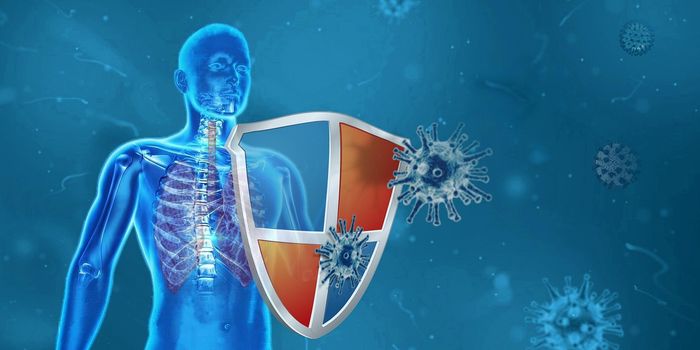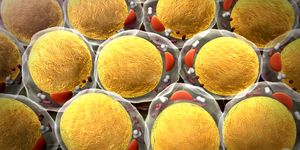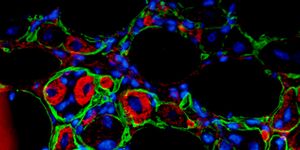
Scientists have shown that small molecules can "hijack" enzyme function in mice, suggesting a possible preventive mechanism for alcohol-related cancers in an at-risk population.
Researchers at the Stanford University School of Medicine have found that by changing the selectivity of an enzyme, a small molecule could potentially be used to decrease the likelihood of alcohol-related cancers in an at-risk population.
Enzymes are enablers. They are highly specialized parts of cellular machinery tasked with bringing together molecules to make it easier for chemical reactions to happen. Sometimes enzymes are defective and malfunction, which can cause disease.
In a study of mice, the researchers discovered a creative way to circumvent the problems caused by a defective enzyme. They used a small molecule to "hijack," or change the function of, another enzyme so that it mimicked and compensated for the function of the broken enzyme.
"We found a molecule that can steer an enzyme to perform a new function," said Daria Mochly-Rosen, PhD, professor of chemical and systems biology, who is the senior author of a paper about the study. Che-Hong Chen, PhD, a senior research scientist, is lead author of the paper, which was published online Feb. 23 in the Proceedings of the National Academy of Sciences.
Specifically, the researchers found that a small molecule could convert a particular enzyme from being ineffective at metabolizing alcohol-derived acetaldehyde to being very effective at the process. Although this molecule, Alda-89, is not suitable for use in humans because of its toxicity, enzyme hijacking is a promising new route for drug discovery, the researchers said. Finding other, safer molecules that can hijack enzymes could help prevent certain human cancers and is the current focus of the Mochly-Rosen laboratory.
"What is novel about this study is using a small molecule to co-opt a related enzyme to help a broken one," said Daniel Erlanson, PhD, who has worked in the pharmaceutical industry for 17 years and is president and co-founder of Carmot Therapeutics, a biotechnology company. "This is a really clever way to address a genetic disorder that has not received much attention." Erlanson was not involved in the research.
Beware of beer - and yogurt
When most people and animals consume alcohol, the body digests it rapidly, within a few hours. One of the byproducts of alcohol metabolism is a chemical called acetylaldehyde. According to the World Health Organization, acetylaldehyde is a Group-1 carcinogen, which means there is a direct link between exposure and cancer.
For most people, acetylaldehyde is not a major health risk - though it can contribute to hangover symptoms - because an enzyme called ALDH2 quickly converts it to a harmless acid. But for some, acetylaldehyde is a big problem.
These people lack a working version of ALDH2 because of a genetic mutation. ALDH2 deficiency is the most common genetic mutation in humans, affecting about 40 percent of East Asians - some 560 million people, or nearly 8 percent of the world's population. Without a working enzyme, the body cannot clear the toxic acetylaldehyde quickly. When people with the ALDH2 mutation consume moderate amounts of alcohol, they experience symptoms ranging from severe flushing of the skin, impaired functioning, headache, nausea and palpitations. People with defective ALDH2 enzyme are also at an increased risk for various alcohol-related cancers of the mouth, throat and upper gastrointestinal system. Among people who carry the mutation, nondrinkers are about twice as likely to develop such cancers, while heavy drinkers who also smoke are 100 times more likely. The ALDH2 mutation has also been linked with colorectal, lung and liver cancers, likely due to elevated acetaldehyde exposure.
"Acetylaldehyde exposure does not just happen from drinking alcohol; it is also present in fermented foods like soy sauce and yogurt," Chen said, adding that he believes the danger of acetaldehyde toxicity is under-recognized and is a great public health risk for a large segment of the East Asian population.
From small molecules to mice
Another enzyme, ALDH3A1, contributes minimally to alcohol metabolism. But the researchers wanted to see if using a small molecule to hijack the function of ALDH3A1 could increase its role in the process.
The researchers studied mice with and without the defective ALDH2 enzyme. They used computer models to visualize the shapes of ALDH2 and ALDH3A1. Both are aldehyde dehydrogenases, enzymes that detoxify aldehydes by converting them into acids. The researchers specifically focused on what the "active site" looked like for each enzyme. An enzyme's active site is like a keyhole: If a molecule fits into the active site, the enzyme changes shape in a way that makes a chemical reaction easier. The researchers compared the shapes of the active sites for ALDH2 and ALDH3A1 with a library of small-molecule structures. Molecules that looked like they would fit into the active sites were tested in mice for their ability to increase the activity of ALDH3A1. The most active compound for ALDH3A1 was a small molecule named Alda-89.
Previously, the researchers had identified and studied another small molecule, Alda-1, that increases the activity of the ALDH2 enzyme. After being injected with alcohol, mice with and without defective ALDH2 were given just Alda-1, just Alda-89 or both small molecules together to see which combination changed the activity of ALDH3A1. Alda-1 was not effective by itself, but together with Alda-89 it boosted the clearance of toxic acetylaldehyde via ALDH3A1 in both groups of mice.
"This really is a beautiful scientific study," Erlanson said. "It goes from very fundamental biochemistry and enzymology, onto structural biology and cell biology, and finishes with animal work. It is a tour de force."
If the shoe fits
Chen described hijacking an enzyme with a small molecule as similar to figuring out how to modify a pair of shoes that are too loose.
"You could stuff a piece of newspaper inside the shoes to make them fit better," Chen said. "The piece of newspaper has to be there in order to create a better fit."
The too-big shoe is the ALDH3A1 enzyme, acetaldehyde is the foot, and the piece of newspaper is Alda-89. When the small molecule bound to the active site of ALDH3A1, the enzyme was altered in such a way that enabled it to more effectively metabolize acetylealdehyde in laboratory mice that had defective ALDH2 activity.
Mochly-Rosen, who is also the George D. Smith Professor in Translational Medicine, and Chen founded ALDEA Pharmaceuticals, a company that focuses on drug discovery of aldehyde dehydrogenase activator molecules. Mochly-Rosen holds stock in the company but otherwise is not involved with it; Chen holds stock and is a scientific adviser to the company.
The other co-author of the paper is Leslie Cruz, PhD, former postdoctoral scholar at Stanford.
 Scientists have shown that small molecules can "hijack" enzyme function in mice, suggesting a possible preventive mechanism for alcohol-related cancers in an at-risk population.
Scientists have shown that small molecules can "hijack" enzyme function in mice, suggesting a possible preventive mechanism for alcohol-related cancers in an at-risk population.







